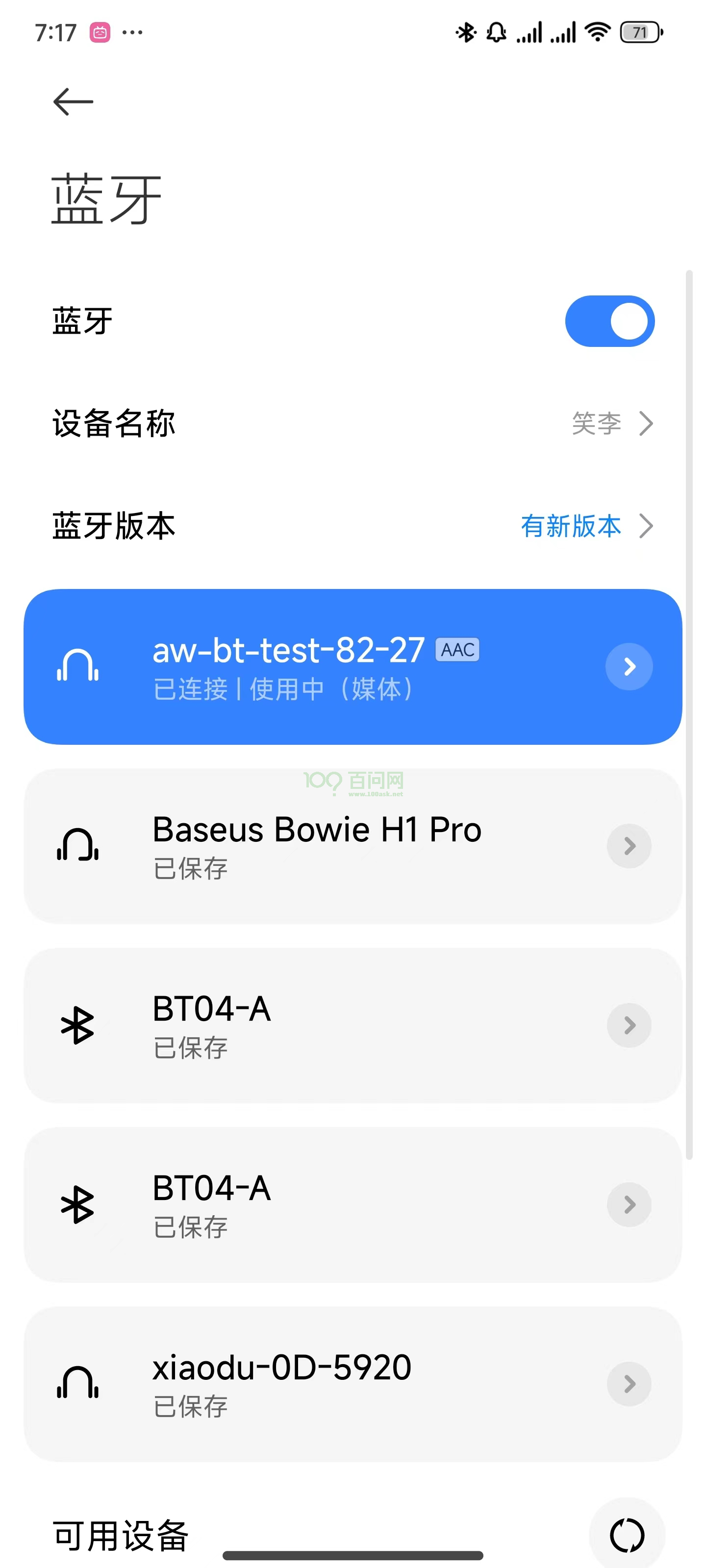蓝牙配对
本章节来讲解如何配对蓝牙,T113i-Industrial开发板板载的是 XradioTech 所设计的 XR829 蓝牙 模组。
前提条件
在进入本章节学习之前,请做好以下准备。
准备工作:
硬件:
- T113i-Industrial开发板
- usb typeC线 X2
软件:
- 全志线刷工具:AllwinnertechPhoeniSuit.zip
- 全志USB烧录驱动:AllwinnerUSBFlashDeviceDriver.zip
硬件介绍
蓝牙功能特性
XR829 模组是一款集成了2.4G IEEE 802.11b/g/n标准的无线连接解决方案,并且支持蓝牙2.1/4.0/4.1协议标准。它主要应用于短距离无线连接,如平板电脑、智能电视等设备。以下是 XR829 模组蓝牙的一些功能特性:
- 兼容IEEE 802.11b/g/n标准,最高速率可达150Mbps,同时支持蓝牙V2.1/4.0/4.1双模模式 。
- 具有2.7-5.5V的宽电压输入范围,集成了高效的SMPS和LDO电源系统 。
- 领先的功耗水平和高集成度,外围设备精简 。
- 内置PTA电路,有效增强BT共存场景的性能 。
- 支持多种时钟输入,包括XTAL时钟输入和32768低频时钟 。
- 蓝牙功能支持包括Class1、2、3,高速UART接口,最大波特率达到4Mbps,自适应跳频技术,以及SCO和eSCO支持 。
- 支持A-law,μ-law和CVSD语音的转码器,以及sniff / hold / sniff-sub-rating低功耗模式 。
- 提供SDIO2.0接口,适用于多种应用场景,如平板电脑、便携式多媒体播放器、智能电视及电视盒等 。
登录开发板终端
看到这里,如果不知道怎么连接硬件,怎么打开串口终端,请参考前面《快速启动》章节里的启动开发板文章。
配对蓝牙
打开串口终端后,开机进入开发板,执行bt_test -i,发现蓝牙起不来,报错。
查看/etc/bluetooth/bt_init.sh
start_hci_attach()
{
h=`ps | grep "$bt_hciattach" | grep -v grep`
[ -n "$h" ] && {
killall "$bt_hciattach"
}
# reset_bluetooth_power
"$bt_hciattach" -n ttyAS1 xradio >/dev/null 2>&1 &
wait_hci0_count=0
while true
do
[ -d /sys/class/bluetooth/hci0 ] && break
usleep 100000
let wait_hci0_count++
[ $wait_hci0_count -eq 70 ] && {
echo "bring up hci0 failed"
exit 1
}
done
}
发现脚本有错:"$bt_hciattach" -n ttyAS1 xradio >/dev/null 2>&1 &
串口1的设备节点是/dev/ttyS1:
# ls /dev/tty
tty tty14 tty20 tty27 tty33 tty4 tty46 tty52 tty59 tty8
tty0 tty15 tty21 tty28 tty34 tty40 tty47 tty53 tty6 tty9
tty1 tty16 tty22 tty29 tty35 tty41 tty48 tty54 tty60 ttyS0
tty10 tty17 tty23 tty3 tty36 tty42 tty49 tty55 tty61 ttyS1
tty11 tty18 tty24 tty30 tty37 tty43 tty5 tty56 tty62 ttyS2
tty12 tty19 tty25 tty31 tty38 tty44 tty50 tty57 tty63 ttyS3
tty13 tty2 tty26 tty32 tty39 tty45 tty51 tty58 tty7
# ls /dev/tty
修改如下:
start_hci_attach()
{
h=`ps | grep "$bt_hciattach" | grep -v grep`
[ -n "$h" ] && {
killall "$bt_hciattach"
}
# reset_bluetooth_power
"$bt_hciattach" -n ttyS1 xradio >/dev/null 2>&1 &
wait_hci0_count=0
while true
do
[ -d /sys/class/bluetooth/hci0 ] && break
usleep 100000
let wait_hci0_count++
[ $wait_hci0_count -eq 70 ] && {
echo "bring up hci0 failed"
exit 1
}
done
}
重启开发板。
再次执行bt_test -i
# bt_test -i
[ACT D][ring_buff_init,27]enter
[ACT D][ring_buff_start,173]ring buffer start enter
[ACT D][ring_buff_start,187]ring buffer start quit
[ACT D][ring_buff_init,27]enter
[ACT D][ring_buff_start,173]ring buffer start enter
[ACT D][ring_buff_start,187]ring buffer start quit
1970-01-01 09:55:24:756: BTMG[_bt_manager_set_default_profile:374]: enable default profile from bt config
1970-01-01 09:55:24:756: BTMG[_bt_manager_enable:258]: btmanager version: Version:4.0.4.20231208, builed time: Jul 16 2024-16:53:44
1970-01-01 09:55:24:756: BTMG[_bt_manager_enable:259]: enable state: 1, now bt adapter state : 0
197[ 286.262531] sunxi-rfkill soc@3000000:rfkill@0: block state already is 1
0-01-01 09:55:24:757: BTMG[bt_test_adapter_status_cb:74]: bt is turnning on.
[ 286.471759] sunxi-rfkill soc@3000000:rfkill@0: set block: 0
[ 286.488049] sunxi-rfkill soc@3000000:rfkill@0: bt power on success
[ 286.515417] [XR_BT_LPM] bluedroid_write_proc_btwake: bluedroid_write_proc_btwake 1
[ 286.523960] [XR_BT_LPM] bluedroid_write_proc_btwake: wakeup bt device
[ 286.531339] [XR_BT_LPM] bluedroid_write_proc_lpm: disable lpm mode
Starting bluetoothd: OK
1970-01-01 09:55:29:953: BTMG[bt_routine:102]: bt adapter info:
address:6E:D6:22:1F:82:27
Name: BlueZ 5.54
Alias: aw-bt-test-82-27
Discoverable: 1
DiscoverableTimeout: 180
[ACT D][ring_buff_init,27]enter
1970-01-01 09:55:30:199: BTMG[bt_test_adapter_status_cb:59]: BT is ON
1970-01-01 09:55:30:202: BTMG[bt_agent_register:226]: set io capability: KeyboardDisplay
1970-01-01 09:55:30:208: BTMG[bt_manager_set_scan_mode:208]: enter
1970-01-01 09:55:30:209: BTMG[pfd1_thread_process:1008]: enter
[BT]:
成功启动蓝牙,这样就可以打开手机配对蓝牙aw-bt-test-82-27了。

配对成功后,串口终端打印信息如下:
[BT]:1970-01-01 09:56:01:896: BTMG[bt_test_agent_authorize_service_cb:192]: AGENT: 04:10:6B:F9:43:23 Authorize Service 0000110d-0000-1000-8000-00805f9b34fb
1970-01-01 09:56:02:183: BTMG[supervise_pcm_worker_start:131]: transport A2DP:AAC
1970-01-01 09:56:02:184: BTMG[a2dp_pcm_worker_routine:115]: codec:AAC, sampling:44100, channels:2, format_size:2
1970-01-01 09:56:02:191: BTMG[a2dp_pcm_worker_routine:149]: Starting PCM loop
1970-01-01 09:56:02:545: BTMG[bt_test_agent_authorize_service_cb:192]: AGENT: 04:10:6B:F9:43:23 Authorize Service 0000110e-0000-1000-8000-00805f9b34fb
1970-01-01 09:56:02:590: BTMG[bt_test_a2dp_sink_connection_state_cb:205]: A2DP sink connected with device: 04:10:6B:F9:43:23
1970-01-01 09:56:02:626: BTMG[bluez_signal_mediatransport_properties_changed:506]: Volume is :59
1970-01-01 09:56:02:626: BTMG[bt_test_avrcp_audio_volume_cb:287]: AVRCP audio volume:04:10:6B:F9:43:23 : 59
1970-01-01 09:56:03:058: BTMG[bt_test_avrcp_play_state_cb:260]: BT palying music paused with device: 04:10:6B:F9:43:23
1970-01-01 09:56:03:061: BTMG[bt_test_avrcp_track_changed_cb:276]: BT playing music title: Not Provided
1970-01-01 09:56:03:061: BTMG[bt_test_avrcp_track_changed_cb:277]: BT playing music artist:
1970-01-01 09:56:03:061: BTMG[bt_test_avrcp_track_changed_cb:278]: BT playing music album:
[BT]: